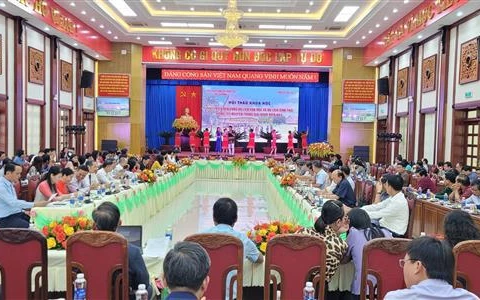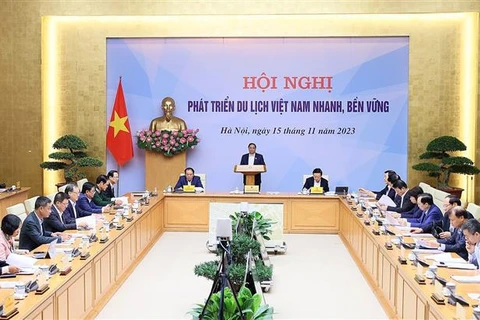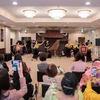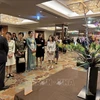Hanoi (VNA) – Engaging the community in the preservation of natural resources and cultural heritage values has an important role to play in boosting sustainable development since it will bring substantial benefits to the national economy.
Preservation of cultural heritage
According to Dr. Nguyen Thi Thu Trang from the Ministry of Culture, Sports and Tourism’s Department of Cultural Heritage, cultural heritage could meet the development requirements of the cultural industry, especially cultural or heritage tourism.
However, cultural heritage is only preserved when it is fully tapped for comprehensive development of the Vietnamese people, she said, adding the heritage must be safeguarded, and able to create sustainable livelihoods for the community.
Ninh Binh is the first and the only locality in Vietnam possessing “double” UNESCO titles with its Trang An Scenic Landscape Complex – mixed Cultural and Natural Heritage of the World.
The management board of the Trang An complex said that since the complex received the UNESCO’s recognition on June 25, 2014, its standout values have been honoured and preserved. There is an increasing awareness from the community of the significance of the heritage site, while the popularisation of the heritage’s values has been enhanced
The province has organised the Ninh Binh – Trang An Festival - a national cultural tourism event to promote cultural exchange and honour cultural heritage in tandem with tourism development.
Director of the provincial Department of Culture, Sports and Tourism Nguyen Manh Cuong said that a story of Hoa Lu ancient capital’s history and culture was highlighted at the the second Ninh Binh – Trang An Festival taking place on December 26-31, with a real scene show meticulously arranged on the background of Trang An complex’s mystical space.
Thanks to the province’s initiatives to promote its heritage, Ninh Binh has enjoyed robust tourism growth. The number of visitors to the province has risen 39%, while tourism revenue has surged 39% since 2015.
During January – September, the province hosted more than 5.5 million visitors, up 99.1% year-on-year, and gained an estimated 5 trillion VND (205.6 million USD) from tourism services. Tourism revenue has made significant contributions to preserving and renovating cultural heritage items within the Trang An complex.
Over the past time, Ninh Binh has made a transition from agriculture-based economy to service-based economy with green and sustainable growth. The move has helped promote the vitality, potential and values of local heritage items, making them an asset of the community.
More than 7,000 local women have contributed to the local preservation efforts by engaging in boat riding and cleanup activities at the complex.
A boost to poverty alleviation
Director General of the Vietnam National Administration of Tourism at the Ministry of Culture, Sports and Tourism Nguyen Trung Khanh said that tourism has bolstered the development of other sectors and restored traditional festival and crafts, while promoting economic restructuring.
The non-smoke industry has generated a number of jobs, contributing to alleviating poverty, giving a facelift to the rural areas, and improving local livelihoods, he said. Developing tourism in tandem with preserving the environment and the value of cultural heritage is important to boost local socioeconomy, and sustainable tourism development, he explained.
Khanh highlighted that Vietnam, boasting more than 40,000 relic sites and 15 UNESCO intangible cultural heritage, has huge potential to build cultural tourism offerings.
Many localities have capitalised on their cultural heritage values to form diverse tourism products, including a tour connecting ASEAN countries’ heritage, Hue Festival, Nha Trang Sea Festival, Ha Long Carnival, culinary festivals, and stellar art shows such as Hoi An Memories and the Quintessence of Tonkin.
Vietnam has been honoured as a leading destination in Asia for many years. Most recently, the country won the World’s Leading Heritage Destination at the World Travel Awards in 2023 for the fourth time so far.
Together with the title obtained in 2019, 2020, and 2022, this time’s award shows the globally outstanding values and attractiveness of the country’s cultural heritage to the international community.
Several destinations of Vietnam were also granted different awards this year. Among them, Hanoi won the World’s Leading City Break Destination title while Phu Quoc in the Mekong Delta province of Kien Giang was named the World’s Leading Nature Island Destination. Moc Chau in the northwestern province of Son La was listed as the World’s Leading Regional Nature Destination, Ha Nam province the World’s Leading Regional Cultural Destination, and Tam Dao in the northern province of Vinh Phuc the World’s Leading Town Destination.
The awards and titles are a vivid illustration for the country’s efforts to promote heritage values in tourism and socioeconomic development./.

























